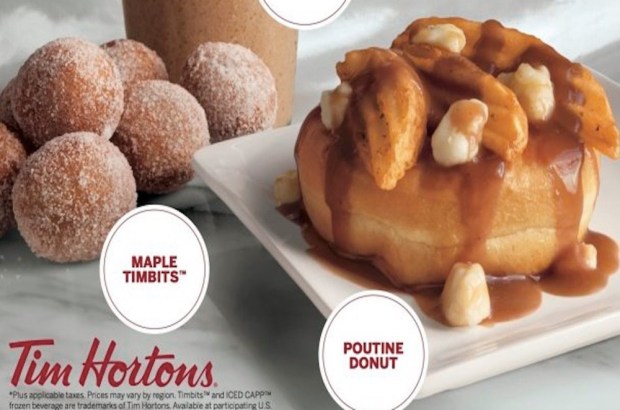Tim Hortons And The Innovative Donut

Donuts used to be one of the more standard staples of the American “balanced” breakfast. There was variety of course- but within limits. Plain cake, glazed, chocolate dipped, Boston creme, powdered sugar and jelly was the standard line – with perhaps the occasional cruller or blueberry cake thrown in for exoticism.
The last five to 10 years, however, have been a golden era for the exotic donut. Consumers can still find the standard line-up, of course, but these days it’s also possible to get a maple bacon donut, a jalepeno cheese donut, an Apple Jax and Fruit Loops donut to name a quick few of the near infinitude of ridiculously fancy donuts the marketplace has on offer.
One can even buy a poutine donut, if they so desire.
Or at least one could have had they been at a Tim Hortons on July 1 in one of three American states (Ohio, Michigan and New York) with a desire to celebrate Canada Day so burning they were willing to consume a honey dip donut covered in cheese curds, potato wedges and gravy. It was not, as you may suspect, intended as an act of aggression to celebrate the 150th anniversary of Canada.
“We’re proud of our Canadian heritage, and we want to share a piece of that in the United States,” Felipe Athayde, executive vice president of Tim Hortons U.S. “Our new Canadian-inspired treats are a great way for Americans to get in on the 150th celebration of their friendly neighbor next door.”
And while the poutine donut was certainly Tim Hortons’ most eye-catching (and potentially stomach-churning) innovation this summer – its biggest and longest awaited is finally debuting.
Canada’s favorite donut shop has rolled out its mobile order-ahead function in its mobile app – after what has been an approximately four-month delay. Customers, after downloading the new app, log in via Facebook, Google or email and register a card or to use Apple Pay. Android Pay is not yet an option. From there, the app displays pictures of menu items that customers can select and modify. Once done, they pay, come in, grab their order and be on their way; or chose dine-in and grab their food to eat in house.
The app also allows customer tracking so that orders are timed with customer arrival.
“The team will start making the product while you’re pulling into the parking lot,” a local franchise owner told the CBC. “You can walk in, grab it, walk out.”
The launch is a graduated roll-out, meaning it will slowly move out as additional franchises add the mobile order-ahead capacity. Its entry into the market comes nearly three year after Tim Hortons first announced its interest in incorporating mobile order-ahead. The launch had initially been planned for late March, but a large group of franchisees alleged that the technology was not yet perfected, and the launch had to be delayed.
“We had very serious concerns,” an owner noted. “We felt it was going to cause a lot of chaos from the operations side.”
Moving To Mobile Payments
Apart from expansion into mobile-order-ahead, Tim Hortons has also decided to raise the level of its mobile payments game in store.
Customers that have a TimCard (a Tim Hortons gift card) – can add it to the TimmyMe mobile app and use their device in place of the card going forward in store by scanning or tapping. The card works on iOS and Android (it even works on Blackberry devices, according to reports) but again is available in limited roll out.
So will the digital upgrades – rolling out in phases to help Tim Hortons close the gap with its much more digitally enabled U.S.-based competitor Dunkin’ Donuts?
According to the experts, it’s a start, but Dunkin’ already has a pretty convincing head start.
“The operators that are slow to the game, they really need to increase their rollout of these apps to connect with consumers,” noted Toronto-based industry analyst Robert Carter with NPD Group.
Carter notes that with restaurant sales largely flat, Tim Hortons’ customer base will probably have to come at the expense of someone else and among the better ways these days “to steal clientele” is to offer a mobile order-and-pay app that’s convenient and saves time.
That has proved challenging. Starbucks learned the hard way that order-ahead lines can be longer than the regular line if the restaurant hasn’t prepared sufficiently for spiking demand.
But, according to the operators the CBC spoke to, Tim Hortons took the extra time to fix the operational issues.
“We’re good to go.”
.
